| Common name | Image | Taxonomy | Care Level | Growth rate | Nutrient uptake | Lighting | Waterflow | Palatable | Description | Max size |
| Mermaid's wine glass | | Acetabularia sp. | Moderate[23] | Slow[23] | Poor[23] | High[23] | Low[23] | Yes[23] | A beautiful and interesting genus of algae which, unfortunately, tends to be short-lived in aquariums. It grows a disc-like appendage which is more pronounced in certain species, is easily broken when removed from water, and may be removed to start a new colony. A hard surface to attach to as well as calcium supplementation are required to grow the calcified algae.[23] | 4 in (10.2 cm)[23] |
| Basket weave | | Anadyomene sp. | Moderate[24] | Slow[24] | Poor[24] | Moderate[24] | Moderate[24] | To some fish[24] | Most specimens make their way into aquariums through live rock and amongst calcareous algae from the wild, staying small in captivity. It possesses rigid, variable, irregularly shaped blades which are characterized by their patterned veins. Anadyomene saldanhae and Anadyomene stellata are the most popular species of this genus.[24] | 10 in (25.4 cm)[24] |
| Fan weed | | Avrainvillea sp. | | | | | | | This species of algae grows a central stalk supporting a single, fan-shaped blade.[25] | |
| Green sea sausage seaweed | | Bornetella nitida | Moderate[26] | | | Moderate[26] | Low[26] | Not really[26] | In the wild, this algae grows in shallow water environments such as tide pools and on tumbling beach rocks. It features firm, yet elastic fronds which grow vertically and take on a reddish coloration during their growth stage. Provided with an environment suitable for soft corals, the algae will grow in its most desirable shape.[26] | 2 in (5.1 cm)[26] |
| Spherical turtle shell | | Bornetella sphaerica | Moderate[27] | | | Moderate[27] | Low[27] | Not really[27] | In the wild, this algae grows in shallow water environments such as tide pools and on tumbling beach rocks. It features firm, yet elastic fronds which take on a reddish coloration during their growth stage. Provided with an environment suitable for soft corals, the algae will grow in its most desirable shape.[27] | 2 in (5.1 cm)[27] |
| Sea fern | | Bryopsis sp. | Easy[28] | Fast[28] [29] | | | | Somewhat[30] | This algae is usually seen as a nuisance though it may be desirable in some aquariums, such as Macroalgae tanks, for its color, growth patterns, and nutrient uptake. Though it is rarely sold on its own, it often enters aquariums through live rock and is hard to eradicate due to its firm grip on rockwork. Its coarse composition aids in accumulating detritus from which it can derive nutrients.[28] [29] [30] | |
| Giant feather algae | | Caulerpa asmeadii | Easy[31] | Moderate[31] | Good[31] | Moderate[31] | Low-Moderate[31] | Somewhat[31] | This is a large species of Caulerpa although unlike its relatives, it won't outgrow its environment as it is slow-growing. It features a thick rhizome which should be pinched when pruned to reduce the amount of pollutants released. Younger individuals may be confused with Caulerpa sertularioides, which inhabits shallower habitats and both may be sold as Feather algae.[31] | 14 in (35.6 cm)[31] |
| Sea mustard | | Caulerpa brachypus | Easy[32] | Fast[32] | Good[32] | Moderate-High[32] | Moderate[32] | Somewhat[32] | Also known as Mini caulerpa. Though this uncommon species of Caulerpa is more palatable than Caulerpa prolifera, herbivorous fish tend not to consume it. It will attach itself to both rocks and sand substrates with rhizoids, is a good refugium addition for nutrient export and housing microinvertebrates, and requires regular pruning.[33] [32] [34] | 1 in (2.5 cm)[35] |
| Umbrella algae | | Caulerpa chemnitzia | Easy[36] | Fast[36] | Excellent[36] | Moderate[36] | Moderate-High[36] | Not really[36] | Rarely seen in the hobby and can be found in dim habitats in the wild. The algae is excellent at stripping a tank of nutrients so it must be carefully monitored. Two varieties exist, one with smooth, round blades and the other with concave blades. Was known as Caulerpa peltata and also may be called Saucer algae and Mushroom algae.[37] [36] [38] | 6 in (15.2 cm)[31] |
| Zipper algae | | Caulerpa cupressoides | Easy[39] | Slow[39] | Fair[39] | Moderate-High[39] | Moderate[39] | No[39] | This interesting and undemanding species of Caulerpa prefers to grow on sand, however it can grow off of harder surfaces. The algae features long, stiff stipes bordered by notched blades and is naturally found growing in shallow-water seagrass meadows. Seahorses will readily use its stipes as hitching posts. Also known as Cactus caulerpa.[39] [40] [41] | 8 in (20.3 cm)[39] |
| Banana algae | | Caulerpa cylindracea | Easy[42] | Fast[42] | Excellent[42] | Moderate-High[42] | Moderate-High[42] | No[42] | This tall algae features cylindrical blades, making it resemble a cluster of bananas, as well as a dark green coloration. It is excellent at stripping a tank of nutrients so its size must be limited. Though it is mostly inedible, some fish may nip at its holdfast.[42] | 6 in (15.2 cm)[42] |
| Razor algae | | Caulerpa floridana | Easy[43] [44] | | | Moderate[44] | | | This algae, also known as Florida caulerpa, originates from shallow environments such as lagoons and bays and enters aquariums through Caribbean and Floridian live rock. It is not very popular in the hobby.[44] | |
| Small sea grapes | | Caulerpa lentillifera | Moderate[45] | Fast[45] | | High[46] | Moderate[46] | Yes[46] | This species of Caulerpa prefers to grow on rockwork though it may venture out onto the substrate. Under strong lighting, it will grow dense blades, resembling clusters of grapes. Additionally, it is known to be edible to humans and is also called Green caviar, Latok, and Umibudo.[45] [46] | 6 in (15.2 cm)[47] |
| Fern algae | | Caulerpa mexicana | Easy[48] | Moderate[48] | Good[48] | Moderate[48] | Low-Moderate[48] | Somewhat to fish[48] | This species of tight-bladed Caulerpa can grow on hard surfaces as well as sandy and muddy substrates. In turbulent surroundings, it grows somewhat compact and in calmer surroundings, it grows taller. Its adaptability to lighting requirements allows it to grow in environments without direct lighting amongst other algae (such as under ledges).[48] | 8 in (20.3 cm)[48] |
| Palm tree algae | | Caulerpa paspaloides | Easy[49] | Moderate[49] | Excellent[49] | Moderate[49] | Low-Moderate[49] | Somewhat[49] | This species of Caulerpa is a good nutrient export choice as it pollutes aquariums less often than its relatives and is fast growing. It should be pruned regularly as its fine structure captures undesirable substances. Under more intense lighting, the algae's palm-shaped blades will grow more compact and triangular in addition to taking on a darker shade of green.[49] | 12 in (30.5 cm)[49] |
| Bladed sand moss | | Caulerpa prolifera | Easy[50] | Fast[50] | Excellent[50] | Moderate[50] | Low-Moderate[50] | Somewhat[50] | Bladed sand moss is well-suited for aquariums as it grows slower than other members of its genus and is easily pruned. It desires sandy substrates, inhabiting seagrass meadows in the wild, and will grow wider blades in turbulent water and taller, thinner blades in calmer environments. Out of all the Caulerpa species that are commercially available, this one is the most popular and widespread, commonly used to cover sand beds in marine planted aquariums.[50] [51] | 6 in (15.2 cm)[50] |
| Coarse sea grapes | | Caulerpa racemosa | Easy[52] | Fast[52] | Excellent[52] | Moderate-High[52] | Moderate-High[52] | Somewhat[52] | Unlike other species of Caulerpa, this one grows round, clustered blades. It is notorious for releasing spores and stripping tanks of available nutrients as well as its invasively rapid growth (having given the entire Caulerpa genus a bad rap). As such, it must be carefully monitored and pruned. Many varieties of this algae exist worldwide which are highly varied and inhabit shallow-water environments.[52] [6] | 8 in (20.3 cm)[52] |
| Sawtooth algae | | Caulerpa serrulata | Easy[53] | Moderate[53] | Good[53] | Moderate[53] | Low-Moderate[53] | Somewhat[53] | This smaller sized, hardy species of algae is often available and put in refugiums for nutrient export or used to create thick bushes in the foreground of an aquarium. It originates from shallow habitats where it prefers to grow on small rocky objects and its stiff nature makes it unappetizing to most organisms. Weaker lighting will lessen the jaggedness of its twisted blades.[53] [54] | 5 in (12.7 cm)[53] |
| Green feather algae | | Caulerpa sertularioides | Easy[55] | Fast[55] | Excellent[55] | Moderate[55] | Low-Moderate[55] | Yes[55] | This shallow-water Caulerpa species features fronds with rounded tips. It is very popular among hobbyists although it grows quickly, easily taking over aquariums. However, it is a great choice for refugiums considering how many fish and invertebrates enjoy eating it. The algae prefers to grow on hard surfaces, yet its adaptability allows it to also grow on the sand bed and climb aquarium walls.[55] | 8 in (20.3 cm)[55] |
| Killer algae | | Caulerpa taxifolia | Easy[56] | Fast[56] | Excellent[56] | Moderate[56] | Low-Moderate[56] | No[56] | Also known as Fern algae and Feather plant, this algae can become quite invasive in the wild as it is able to survive in a wide range of temperatures and grows rapidly. For this reason, it is rare within the United States. It appears similar to Caulerpa mexicana although its dark-green fronds are more uniform and spaced further apart. The algae will spread on both rocks and sand.[56] [57] | 10 in (25.4 cm)[56] |
| Fluffy green seaweed | | Caulerpa verticillata | Easy[58] | Fast[59] | | Low-High[59] | | | Though this is a rather short species of the Caulerpa genus, Fluffy green seaweed or Fuzzy caulerpa can grow extremely quickly, even on walls. As such, it is only suitable for marine planted aquariums. Regular pruning should be performed by twirling the algae's blades around one's fingers, separating it's holdfast from hard surfaces. Amphipods and copepods enjoy living within the algae.[59] [60] | 5.9 in (15.0 cm)[58] |
| Spaghetti algae | | Chaetomorpha sp. | Easy[61] | Fast[61] | Excellent[61] | Low-High[61] | Moderate[61] | Not really[61] | Also called Chaeto, this algae grows as a tangled mass of green filaments and originates from shallow, nutrient rich environments. It is incredibly popular with aquarists since it serves as habitat for microinvertebrates (such as amphipods and copepods) and rapidly consumes excess nutrients (though care must be taken to replenish these nutrients such as iron, nitrates, and phosphates). For this reason, it is often kept in a refugium where it can either be tumbled or left to float. Despite being hardy and easy to grow, care must be taken to meet the different environmental requirements of the different species of Spaghetti algae.[61] [62] [63] | 24 in (61.0 cm) mound[61] |
| Tall hair alga | | Chaetomorpha aerea | Easy[64] | Fast[65] | Excellent[65] | Moderate[64] | Moderate[64] | Yes[64] | Once known as Chaetomorpha crassa. It is rare example of a hair algae species suitable for marine aquariums, being an excellent refugium addition. In captivity, the stiff, filamentous algae serves as habitat for microinvertebrates, provides nutrient export, and can be fed to herbivores, though it should ideally be tumbled. Naturally, this algae is found in the intertidal zone.[64] | 6 in (15.2 cm) mound[64] |
| Floating chaeto | | Chaetomorpha linum | Easy[66] | Fast[66] | Excellent[66] | Moderate-High[66] | Moderate[66] | No[66] | Also known as Spaghetti algae. This stable, greenish algae is composed of unbranched, tangled filaments, finer and more flexible than those of Chaetomorpha spiralis. It is excellent at nutrient export, but care must be taken to replenish said nutrients in a system containing Chaetomorpha linum, such as nitrate, phosphate, Magnesium, Iodine, and Iron. Additionally, herbivorous fish cannot digest this algae, though they might attempt to eat it.[66] [67] | 16 in (40.6 cm)[66] |
| Curly chaeto | | Chaetomorpha spiralis | Moderate[68] | Fast[68] | Excellent[69] | High[68] | Moderate[68] | | Also known as Spaghetti algae and Green hair algae (not Derbesia). This hardy algae is composed of clumped, long filaments, thicker and more brittle than those of Chaetomorpha linum. It is an excellent addition for refugiums, serving as habitat for microinvertebrates and providing nutrient export.[68] [67] | 20 in (50.8 cm)[70] |
| Green tide alga | | Cladophora coelothrix | | | | High[13] | | | This algae is composed of compacted filaments, forming a sphere. It does best in cooler water.[13] | 20 in (50.8 cm)[71] |
| Toadstool algae | | Cladophora prolifera | Easy[43] | Slow[43] | Poor[72] | Moderate-High[72] | Low-High[72] | Somewhat[72] | This species of shallow-water algae grows in clumps on rocks and rubble, featuring rigid, finely branched filaments. Many aquarists believe it is a nuisance since it will become hard to remove after establishing itself. However, microinvertebrates enjoy living wihin the algae, such as starfish. May also be called Green bush, Moss ball, and Sea hair.[73] [43] [74] | 20 in (50.8 cm)[75] |
| Turtleweed | | Chlorodesmis sp. | Expert[76] | Moderate[76] | Good[76] | High[76] | Moderate-High[76] | No[76] | Also known as Maiden's hair plant, this popular, stringy algae is often mistaken for hair algae and enters the aquarium trade on live rock and coral. It is toxic, making it inedible and capable of effecting coral growth, though microinvertebrates enjoy living wihin the algae such as amphipods and copepods. If the blades of the algae turn white, they should be removed.[77] [76] [78] | 8 in (20.3 cm)[76] |
| Dead man's fingers | | Codium sp. | Easy[79] | Slow[79] | Fair[79] | Moderate-High[79] | High[79] | No[79] | Some forms of this algae feature a single holdfast with multiple irregular branches and others encrust surfaces taking on a blob-like shape. They should be placed on hard surfaces and kept in water temperatures under 80 °F (26.7 °C). Though the main structure of Dead man's fingers is inedible, some fish may graze on the fuzzy filaments that cover its surface.[79] [80] [81] | 12 in (30.5 cm)[79] |
| Green fleece | | Codium decorticatum | Easy[82] | Slow[82] | | High[82] | Low[82] | Not really[82] | This desirable algae features thick, fingerlike protrusions that provide habitat for microcrustaceans and can break apart if disturbed. Though it floats, it can be attached to solid surfaces with superglue. In nature, it is distributed worldwide in shallow waters, though it is rare in the aquarium hobby.[82] | 12 in (30.5 cm)[82] |
| Tufted joint algae | | Cymopolia barbata | Moderate[83] | Slow[83] | Fair[83] | High[83] | Moderate-High[83] | Not really[83] | This species of prehistoric-looking algae is rarely available although it may enter aquariums through live rock. It is quite interesting, but requires calcium supplementation as it is calcified. Pieces of the algae may be clipped and fed to Tangs and Rabbitfish. Also known as Palm tree algae.[83] [84] | 12 in (30.5 cm)[83] |
| Usugasane | | Cymopolia vanbosseae | Easy[85] | | | Moderate[85] | Moderate[85] | | In the wild, this algae grows in shallow water environments. It is calcified and its base is white due to the lack of Chlorophyll. In the aquarium, this algae will deteriorate if other algae is allowed to grow on its surface and should be exposed to fluorescent lighting for dense frond growth (though the algae can be grown under LED lighting).[85] | 2 in (5.1 cm)[85] |
| Green bubble weed | | Dictyosphaeria cavernosa | | | | Various[86] | | Somewhat[86] | In the wild, this green to bluish algae thrives in rocky crevices where detritus can accumulate. It will tolerate a variety of lighting intensities and survive in aquariums with low nutrient levels. The algae is made up of easily-seen, bubble shaped cells which, when ruptured, release new cells that will settle throughout an aquarium system.[86] [87] | 5 in (12.7 cm)[87] |
| Isosugina | | Halicoryne wrightii | | | | Moderate[88] | Low[88] | Yes[88] | In the wild, this algae grows in shallow water environments such as tide pools and on tumbling beach rocks. The algae's yellow-green coloration is a result of limestone deposits on its fronds which requires specific Carbonate hardness levels to form. This algae will become weakened if other algae is allowed to grow on its surface.[88] | 2 in (5.1 cm)[88] |
| Large leaf watercress algae | | Halimeda discoidea | Easy[89] | Moderate[89] | Fair[89] | Moderate-High[89] | Moderate[89] | Somewhat[89] | Out of all the Halimeda species, this one possesses the largest segments and unlike its relatives, only grows on hard surfaces. It requires calcium supplementation as it is calcified, making it a good food for grazers (such as Tangs) as it helps keep their digestive tracts free of blockages. Also known as Money plant and Rosette halimeda.[89] [90] [91] | 10 in (25.4 cm)[89] |
| Three finger leaf algae | | Halimeda incrassata | Easy[92] | Moderate[92] | Fair[92] | Moderate-High[92] | Moderate[92] | No[92] | Also known as Money plant, this algae either grows in clumps or forms several branches. It requires calcium supplementation as it is calcified (making it a good food for clearing blockages in the digestive tracts of grazers) and a sand bed at least 4 in (10.2 cm) deep. While generally small, this algae will rapidly reproduce under favorable conditions, sprouting new individuals near its base.[92] [93] | 8 in (20.3 cm)[92] |
| Jointed-stalk algae | | Halimeda monile | | Slow[94] | Fair[94] | Low-High[94] | | No[94] | This algae is ideal for use in aquascaping as it is inedible. Though it can be housed under a wide range of lighting strengths, it grows best under Moderate-High lighting and prefers to grow in finer substrates. It also requires calcium supplementation as it is calcified. Individuals will appear stressed when they attempt to spread, using the majority of their energy to produce new growth.[94] | 8 in (20.3 cm)[95] |
| Prickly pear | | Halimeda opuntia | Easy[96] | Moderate[96] | Fair[96] | Moderate-High[96] | Moderate[96] | No[96] | This algae forms large mounds of tight segments and attaches itself to rocks and sand using several holdfasts. It requires calcium supplementation as it is calcified (making it a good food for clearing blockages in the digestive tracts of grazers). However, under the right conditions, it can be used to form a ground cover. Also known as Money plant, Carpeting halimeda, and Watercress alga.[96] [97] [98] [99] | 10 in (25.4 cm)[96] |
| Money plant | | Halimeda scabra | | | | Low-High[100] | | | This algae is named after its coin-shaped segments. Though it can be housed under a wide range of lighting strengths, it grows best under Moderate-High lighting. It also requires calcium supplementation.[100] | 5 in (12.7 cm)[100] |
| Cactus algae | | Halimeda tuna | | | | Low-High[100] | | | Cactus algae is common on reefs and is amongst the most imported species of the Halimeda genus for aquariums. Though this algae can be housed under a wide range of lighting strengths, it grows best under Moderate-High lighting. It requires calcium supplementation as it is calcified, making it a good food for grazers (such as Tangs) as it helps keep their digestive tracts free of blockages. Also known as Money plant.[101] [100] | 5 in (12.7 cm)[100] |
| Ringed finger seaweed | | Neomeris annulata | Moderate[102] | Slow[102] | Fair[102] | Moderate[102] | Low[102] | Somewhat[102] | This species of spongy, fuzzy algae grows in small clusters or individually and spreads by extending its holdfast on rockwork or Mangrove roots and growing new fronds. It is lightly calcified and should be provided with calcium supplementation. Also known as Finger algae and may become highly invasive.[102] [103] [104] | 4 in (10.2 cm)[102] |
| Mermaid's shaving brush | | Penicillus capitatus | Easy[105] | Moderate[105] | Fair[105] | Moderate-High[105] | Low-Moderate[105] | No[105] | This species of algae generally grows out of the sand bed on reef flats and seagrass meadows, anchoring itself with rhizoids, although it may grow on rocks. It requires a sand bed at least 4 in (10.2 cm) deep along with calcium supplementation like many other calcified stem plants. In aquariums, a mature specimen will often die, only to produce new individuals at its base.[105] | 8 in (20.3 cm)[105] |
| Neptune's shaving brush | | Penicillus dumetosus | Easy[106] | Moderate[106] | Fair[106] | Moderate-High[106] | Low-Moderate[106] | No[106] | This species of Penicillus grows to be larger than others of its own genus and features a more tapered top. In the wild, it grows on reef flats and seagrass meadows, anchoring itself with rhizoids. In the aquarium, it requires a sand bed at least 4 in (10.2 cm) deep and calcium supplementation. A mature specimen will often die, only to produce new individuals at its base.[106] | 8 in (20.3 cm)[106] |
| Flat-top bristle brush | | Penicillus pyriformis | Easy[107] | Moderate[107] | Fair[107] | Moderate-High[107] | Low-Moderate[107] | No[107] | This species of Penicillus grows to be larger than others of its own genus and features a completely flattened top. In the wild, it grows on reef flats and seagrass meadows, anchoring itself with rhizoids. In the aquarium, it requires a sand bed at least 4 in (10.2 cm) deep and calcium supplementation. A mature specimen will often die, only to produce new individuals at its base.[107] | 8 in (20.3 cm)[107] |
| Pinecone algae | | Rhipocephalus phoenix | Easy[108] | Moderate[108] | Fair[108] | Moderate-High[108] | Moderate[108] | No[108] | This pinecone-shaped algae attaches itself to sandy substrate (and occasionally rocks) using a bulb-like structure possessing several rhizoids. It requires a sand bed at least 4 in (10.2 cm) deep and calcium supplementation. In the wild, it grows on reef flats, seagrass meadows, and Halimeda forests.[108] | 6 in (15.2 cm)[108] |
| Mermaid's fan | | Udotea flabellum | Easy[109] | Moderate[109] | Fair[109] | Moderate-High[109] | Moderate[109] | No[109] | This species of calcified algae is very popular and requires a sand bed at least 4 in (10.2 cm) deep along with calcium supplementation. Given that its requirements are met and conditions are favorable, an individual Mermaid's fan will rapidly reproduce, sprouting new individuals from its base. Rhizoids also extend from the base, anchoring the algae.[109] | 12 in (30.5 cm)[109] |
| Fan algae | | Udotea orientalis | Easy[110] | Slow[110] | | High[110] | Low[110] | | This species of algae attaches itself to a sand substrate, preferring the same environment as sand-rooted Halimeda such as Halimeda opuntia. Since it grows slowly, algae can easily grow on this species' surface under poor water quality, weakening it.[110] | 2 in (5.1 cm)[110] |
| Gutweed | | Ulva sp. | Easy[111] | Fast[111] | Excellent[111] | Moderate-High[111] | Low-Moderate[111] | Yes[111] | Gutweed or Tube algae is common in both tropical and temperate waters. The algae forms tube-like blades secured by a single holdfast to hard surfaces and Mangrove roots. In the aquarium, this algae should be kept in water temperatures under 80 °F (26.7 °C) and may be used to feed herbivorous fish. It was previously classified under the genus Enteromorpha.[111] [112] | 10 in (25.4 cm)[111] |
| Sea lettuce | | Ulva sp. | Easy[113] | Fast[113] | Excellent[113] | Moderate-High[113] | Moderate[113] | Yes[113] | Sea lettuce is common in both tropical and temperate waters. The algae forms flat sheets which either anchor themselves with holdfasts or float by trapping pearled air bubbles. Its growth rate is comparable to that of Chaetomorpha, is nearly as popular, and is similarly good at absorbing excess nutrients in aquariums, housing microinvertebrates, and requires iron supplementation. It is usually kept in refugiums and since it is relished by many aquarium inhabitants, it can be harvested there and fed to organisms in display tanks. Care must be taken to protect return pumps when using Sea lettuce since the latter can easily clog the former.[113] [114] | 8 in (20.3 cm) mound[113] |
| Winding nori | | Ulva flexuosa | | | | | | Yes[13] | This algae is filamentous in nature and is great for feeding Sea urchins. Once known as Enteromorpha flexuosa.[13] [115] | 24 in (61.0 cm)[116] |
| Grass lettuce | | Ulva intestinalis | Easy[111] | Fast[111] | Excellent[111] | Moderate-High[111] | Low-Moderate[111] | Yes[111] | Also known as Gutweed and Grass kelp and once known as Enteromorpha intestinalis. This increasingly popular, hardy algae is a good refugium addition and can be fed to fish. Individuals may attach to sand or rocks with a holdfast or be left to float. The algae also serves as habitat for microinvertebrates and seahorses will readily use its filamentous blades as hitching posts.[117] [118] [114] [119] | 12 in (30.5 cm)[118] |
| Common sea lettuce | | Ulva lactuca | Easy[120] | Fast[120] | Excellent[120] | Moderate-High[120] | Moderate[120] | Yes[120] | This popular algae grows in ruffled, thin sheets which, in the event it does not feature a holdfast (which it will slowly develop if attached to a rock), will trap pearled air bubbles and cause it to float. Good nutrient uptake, the ability to house microinvertebrates, and palatability by herbivorous fish are characteristic of the algae as well as the necessity for iron supplementation. In low nutrient environments, it may get stressed and become invasive.[114] [120] | 24 in (61.0 cm)[121] |
| Bubble algae | | Valonia sp. | Expert[122] | Moderate[122] | Good[122] | High[122] | Moderate-High[122] | No[122] | Also known as Sailor's eyeballs, this algae is usually viewed as a pest, often entering aquariums on live rock. It has the ability to choke out corals if it grows too large and unfortunately, very few animals consume it (one of which is the Emerald crab (Mithraculus sculptus)). They may be desirable in marine planted aquariums, however. The algae itself is comprised deep green, spore filled spheres.[122] [123] | 8 in (20.3 cm)[122] |
















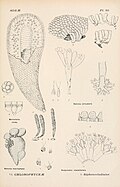

























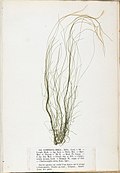
![]()















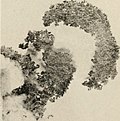













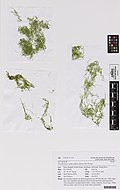








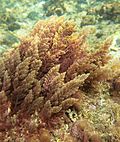






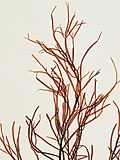






![]()

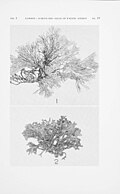







![]()


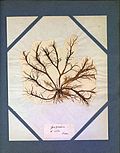

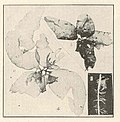





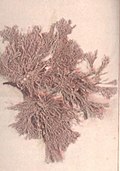
















0 Response to "What Is a Purple and Blue Underwater Plant That Looks Like a Cup"
Post a Comment